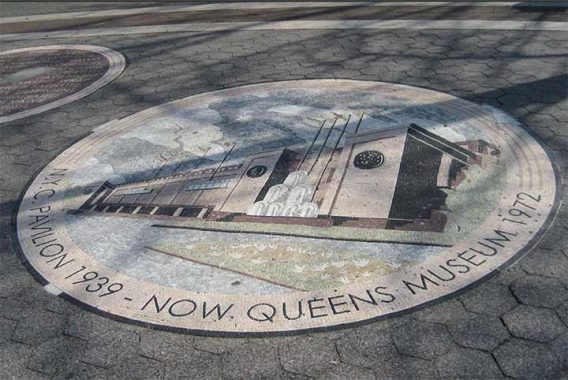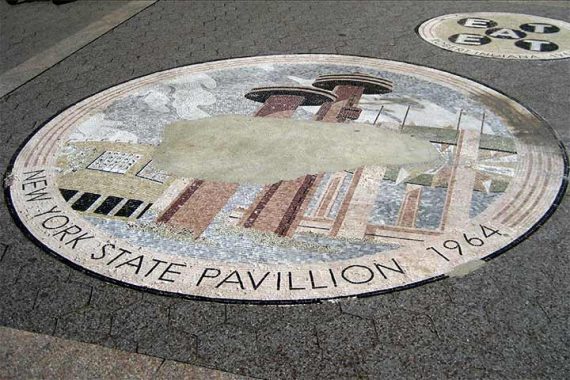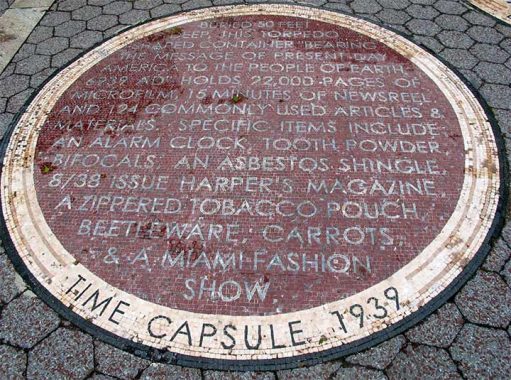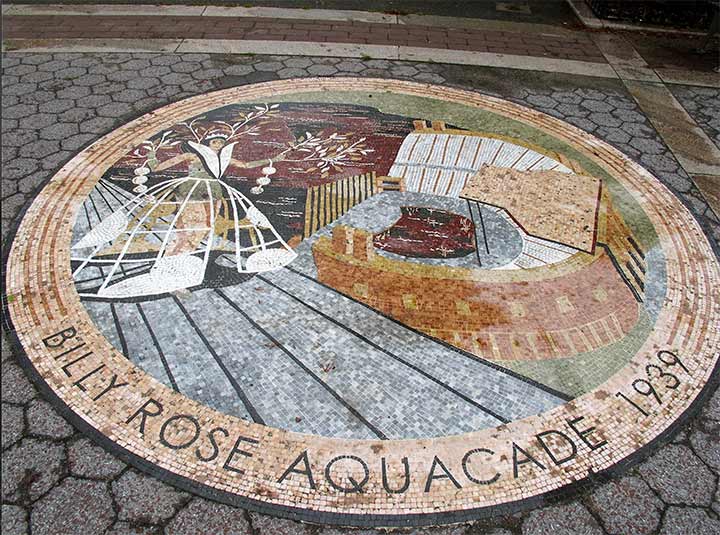
I took a stroll in Flushing Meadows in September 2024 and noted the absolutely decrepit conditions of the sidewalk mosaic medallions located surrounding Dinkins Plaza at the park’s entrance at the west end of the Passerelle Boardwalk. I had been under the impression that these mosaics, which depict scenes from the ’39-40 and ’64-’65 Fairs, dated to 1964 when the park opened; however, they are newer than that, first appearing in the late 1990s. I am unsure of exactly when they appeared, but preservationist/historian Michael Perlman has been in contact with mosaicist Michael R. Golden, who had a hand in their creation.
Though NYC Parks has announced plans to remove the mosaics in their entirety because their now-chipped condition presents, in their opinion, a dangerous situation, I proposed and alternative to Perlman to suggest to Parks: remove them and exhibit them as-is in a venue such as Queens Museum, if restoring them is too cost-prohibitive.
Mike Perlman and local historian Gloria Nash have been doing yeoman’s work researching the mosaics and contacting entities who may be of assistance in their preservation. There has been a good amount of press devoted in recent months:
“Uniting To Restore The World’s Fair Commemorative Mosaics,” Michael Perlman, This Is Forest Hills
“The Fight to Preserve Disappearing World’s Fair Mosaics in Queens, Nicole Saraniero, Untapped Cities
“Communities Unite To Rescue World’s Fair Tributary Mosaics,” Perlman, Queens Gazette
Perlman also provided a link to a 2010 post in 16 Miles of String, a site by Andrew Russeth covering art in NYC and Seoul, South Korea, which provided info about Andy Warhol’s mosaic portrait of parks and traffic czar Robert Moses.
Perlman’s list of current and surviving mosaics:
The current mosaic cartouches:
1. New York Hall of Science (1964)
2. Elsie The Cow (1939)
3. Robert Moses by Artist Andy Warhol (1964)
4. Salvador Dali’s Dream of Venus (1939),
5. Fountain of The Planets (1964)
Missing mosaic cartouches that we are aware of:
1. EAT – Robert Indiana (1964)
2. Billy Rose Aquacade (1939)
3. NYS Pavilion (1964)
4. NYC Pavilion (1939) now Queens Museum (1972)
5. Time Capsule (1939)
6. Time Capsule (1964)
Today, I thought I’d provide a look at the mosaics which have been completely paved over or severely compromised. Above is a depiction of the Billy Rose Aquacade (1939). Surviving into the 1990s, but not quite the 2000s, was a relic not of the ’64-’65 Fair but its 1939-1940 predecessor. The Billy Rose Aquacade, or more properly, the NY State Gertrude Ederle Marine Amphitheatre, featured 10,000 seats looking down on a pool big enough to fit 1,750 tons of water. And what was in the pool? Synchronized swimming bathing beauties. Rose, the aquatic Busby Berkeley, put on quite a show and there was something for the ladies as well, as Rose’s “Aquadonises” included future Tarzan Johnny Weissmuller and future Flash Gordon and future potbelly-masking belt salesman Buster Crabbe.
The Amphitheatre soldiered on for some decades after the Fair, but succumbed to deferred maintenance and was finally pickaxed to oblivion in the mid-1990s. Ten years after the final disappearance of the Aquacade, a pedestrian pavilion slowly took shape along Flushing Meadows’ Meadow Lake. The Aquacade was remembered by this pavement mosaic at the park’s main entrance on the walkway leading to the IRT subway.

One of Flushing Meadows’ only holdovers from the 1939-1940 Fair is the Queens Museum of Art, designed by Aymar Embury II and redesigned in 1994 by Raphael Vinoly and originally the New York City Building. It contains one of the 1964 Fair’s most notable exhibits: The Panorama of New York, a scale model of the entire city showing the city’s bridges, highways, subways, the Empire State Building (15 inches high), more than 800,000 miniatures of every NYC building, the Queens airports with tiny planes overhead, and thousands of tiny homes; plus a notable subtraction on the Lower West Side, replaced by a red, white and blue ribbon.
The New York City Building was the temporary home of the United Nations, from its organization in 1946, to 1952 when it was moved to the newly finished U.N. complex in Manhattan. The state of Israel came into being here in Flushing Meadows in 1948.

When these mosaics chipped from foot traffic or application of salt during winter storms, the city simply concreted over the chipped portions. This mosaic has now been removed entirely.
Designed by Philip Johnson, the NY State Pavilion was among the most striking buildings in a Fair full of them. It consists of the “Tent of Tomorrow” consisting of 16 100-foot columns that supported a 50,000 sq. foot roof of multicolored panels (which was removed in the 1970s) as well as three towers, measuring 60, 150 and 226 feet tall. Fairgoers could ascend top the top of the towers via “Sky Streak” capsule elevators. Inside the pavilion, there was a scale model of the new St. Lawrence River hydroelectric plant, NY State industry information, artwork from the 19th-century Hudson River School, and portraits of NY State colonists.
The NY State Pavilion contained striking visuals both above and below. Texaco funded a giant map of New York State on the pavilion floor with 567 mosaic terrazo panels weighing about 400 lbs. each. Rand McNally supplied the topographic information, and Texaco furnished the location of each of its gas stations in the state. When the pavilion’s roof was removed due to its deterioration borne of general negligence, the Texaco map was open to the elements and was subsequently removed except for a couple of “slices” now in storage. In the mid-1980s the Texaco map was still open to the public, and John Flansburgh and John Linnell of They Might Be Giants filmed a promo video for “Don’t Let’s Start” from their breakthrough eponymous LP there.
Another remnant of the NY State Pavilion is “Theaterama” which originally exhibited pop-art works by Andy Warhol and Roy Lichtenstein. The theatre operated until 1985, when it was closed for renovation, reopening in 1994 as the Queens Theatre in the Park.
The NYS pavilion is one of the Fair’s more recent success stories, as it was given a fresh coat of paint to celebrate its 50th anniversary in 2014 and portions of it are now under renovation.
Above it is a second lost mosaic: A number of contemporary artists were commissioned to create works that would appear on the exterior of the New York State Pavilion, among them Robert Indiana of LOVE fame, who created an “EAT” neon billboard represented in mosaic here.


The pair of mosaics depicting two time capsules placed on the fairgrounds in 1939 and 1964 and their contents have been lost.
A small concrete slab, in its own circular plaza next to the New York State Pavilion, is what remains of the Westinghouse Pavilion. The electrics giant featured a time capsule at its 1939 exhibit, including a slide rule, a woman’s hat, synthetic rubber, 10 million words on microfilm taken from books, magazines and newspapers and messages to the future from Albert Einstein and others. Westinghouse also built a new time capsule in 1964, including filtered cigarettes, a Beatles record, irradiated seeds, freeze-dried foods and a rechargeable flashlight. The cutting edge.
Don’t open till 6964! The time capsule is supposed to last 5000 years. Well, it’s lasted for over 60 years so it’s off to a good start. I wish I could see what it’s going to be like in 6964: I enjoy time travel stories. I’ve seen all three “Time Machine” movies; H.G. Wells’ time traveler made it to April 802,701, so 6965 shouldn’t be that tough. We do know one thing: 6964 will be as different from 1964 as today is from 5000 years ago.
Though these mosaics have been lost there is still hope for the others. I’ll keep Forgotten Fans posted of any progress in these efforts.
Photos courtesy Michael Perlman
If you’d like to contact Michael Perlman, the point man in these efforts, he can be reached at mperlman@queensledger.com
As always, “comment…as you see fit.” I earn a small payment when you click on any ad on the site. Take a look at the new JOBS link in the red toolbar at the top of the page on the desktop version, as I also get a small payment when you view a job via that link.
11/23/24


3 comments
One has to wonder why these intricate original works of art would be placed on ground level. It is predictable that ground level traffic would destroy these over time. Subway mosaic art and signage were placed on vertical walls, that makes sense.
When an out-of-town relative came for a visit, somewhere around 1956, my parents took her and me to a show at the Amphitheatre. (Such shows were discontinued shortly thereafter.) It is one of those memories, from my earliest childhood years, that I recall. Many years later, when the then-named Gertrude Ederle Amphitheatre was demolished, the Parks Department was giving bricks from the building to supporters of Flushing Meadow-Corona Park. I am happy to have one, along with a Certificate of Authentication, which provides the provenance for Brick 236.
I remember the Panorama of New York from the ’64-’65 fair. I think Lloyd Bridges narrated the ride. I also saw it in the ’80s and was operational.